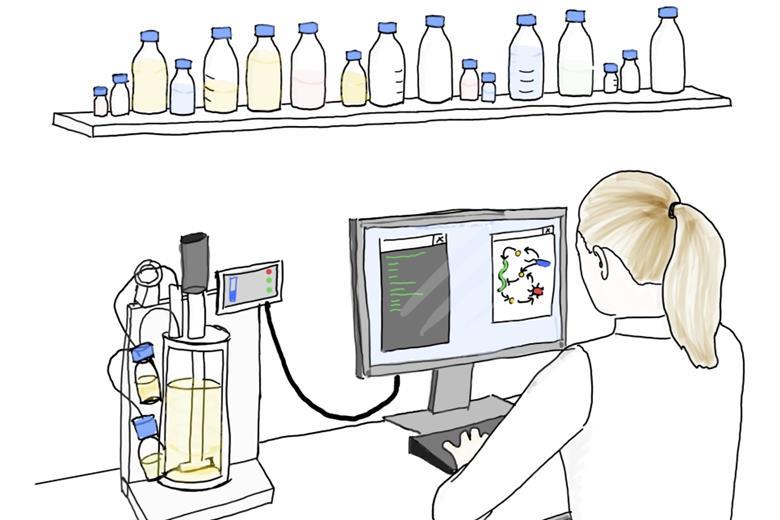Use of synthetic microbial communities has stalled - but we can get moving again

Use of synthetic microbial communities outside the lab is rare - but a more systematic approach could improve confidence in their long-term behaviour and address ethical considerations.
That’s the message from a review of the field by scientists at University College London, ‘Synthetic Microbial Ecology: Engineering Habitats for Modular Consortia’, which has been published in the Journal of Applied Microbiology, an Applied Microbiology International publication.
Led by Dr Alex Fedorec, the review looks at the different mechanisms recent papers have used to control and regulate synthetic microbial communities.
“We look at the different ways studies have grown and measured communities, the types of interactions within them and the ways they react to environmental changes. Finally, we share how recent papers have used these mechanisms to create new communities, by designing them to self-regulate or using external control to manipulate their behaviour,” he says.
Synthetic communities
Among others, the fields of synthetic and engineering biology have been aiming to integrate engineered microbes into existing microbiomes and create entirely synthetic communities for applications ranging from therapeutic to industrial.
However, microbial communities are naturally complex and can exhibit chaotic behaviour. This has hindered their use in bio-industry and makes medical applications unpredictable and potentially unethical, Dr Fedorec says.
“There have been many ad hoc studies in which synthetic communities have been created, not through an extensive design process but by using familiar components. This has meant that much work to date has focused on a small number of microbial species, using a limited palette of interventions, and often with little regard for the community’s long term behaviour.
Wide variety of tools
“However, there are some excellent examples showcasing the wide variety of the tools at our disposal. These have been demonstrated for creating and manipulating interactions within and between members of microbial communities and with their environment.
“Though these studies have helped us to understand what drives community behaviour, designing these communities to function beyond the lab is still quite rare.”
The latest review aims to pull in the breadth of approaches to creating new microbial communities, in order to demonstrate what is available to play with.
Starting with the basics
“We tried to highlight key considerations along the way - starting with the very basics of how one approaches growing and measuring a community, through to the complexities of designing fully engineered microbial strains or computational control strategies,” PhD student and author Louie Destouches says.
“By detailing these approaches and considerations, we create a kind of map which makes it easier to navigate the options that are available to approach the study of synthetic microbial communities.”
While the use of synthetic microbial communities in real world settings has stalled, the team are hoping a more systematic approach to constructing and controlling new communities can not only improve the general understanding of their dynamics, but also improve confidence in their long-term behaviour - which will be key to their ethical use as bio-therapeutics or bio-remediative tools.
Emergent behaviours
“Reflecting the classic Feynman quote, if we are able to recreate the types of emergent behaviours that we observe in wild microbial communities it demonstrates that we understand the processes that drive them,” PhD student and author Yue Casey Chen says.
“From there we can ask questions about specific phenomena of interest, for example how the human microbiome changes over time. Further, by incorporating microbial communities in our bio-based industries, we can potentially expand the current possibilities of production - taking advantage of capabilities typically reserved for multicellular organisms, such as division of labour and the utilization of complex substrates.
“We believe that the systematic design of synthetic microbial communities is a field which deserves further attention because of the exciting prospects that it offers. We highlight the vast number of tools available to engineer communities and the applications they have been used for, but we hope that in the future, more integration between these studies happens so that new approaches can be more easily adopted by others.
Further considerations
“Further considerations include: the development of more accessible platforms for high-throughput exploration and control of communities, wider adoption and sharing of mathematical modelling of microbial communities, and a deeper focus on the interface between synthetic and wild communities.”
All the authors belong to the Fedorec Group research lab at the University College London UK. Alex Fedorec is the Principal Investigator and Louie Destouches, Casey Chen and Alice Cook are PhD students under his supervision funded by the EPSRC or the BBSRC.
’Synthetic Microbial Ecology: Engineering Habitats for Modular Consortia’ has been published in the Journal of Applied Microbiology, an Applied Microbiology International publication.
